|
John R. Neill’s watercolor illustrations for Dorothy and the Wizard in Oz are some of the most beautiful created for the Oz book series. Until recently, it was believed that none of the original artwork for the book survived, but in one of the Lost Art of Oz project’s most exciting discoveries, several spectacular examples have recently come to light, and we can thank one of the “Wizards” of book publisher Reilly and Lee for their preservation.  Frank J. O'Donnell was born in Chicago on May 1, 1892. After attending DePaul University, he was a manager with the Clyde W. Riley Advertising System before becoming the Reilly & Lee Company's director of manufacturing in 1918. O'Donnell was promoted to secretary of the firm in 1929. Three years later, when Frank K. Reilly died, O'Donnell succeeded him as president of Reilly & Lee. O’Donnell and his wife, Louise shared a summer home with their daughters, the walls of which were decorated with original John R. Neill art from the Reilly and Lee archives. Among the treasures were illustrations from Peter and the Princess, The Patchwork Girl of Oz, The Emerald City of Oz and 5 watercolor illustrations for Dorothy and the Wizard in Oz. In 1956, Reilly and Lee published their first edition of L. Frank Baum’s The Wizard of Oz. For this edition, artist Dale Ulrey created entirely new artwork. Ulrey chose Frank O’Donnell as the model for the character of the Wizard, and featured him prominently on the edition’s dust jacket. When the Henry Regnery Company acquired Reilly & Lee in 1959, O'Donnell retired. Even so, he retained an office that he would sometimes visit. O'Donnell died at age 70 on November 27, 1962,
Lost Art of Oz, Founder Brady Schwind was honored to connect with Louise O’Donnell’s family who graciously shared images of the artwork they continue to cherish. With their kind permission, we are thrilled to share some of these fantastic treasures. Special thanks to Atticus Gannaway and Mark Terry for their contributions to this article.
0 Comments
 The Lost Art of Oz founder, Brady Schwind was honored to be a part of an expert panel discussion celebrating all things Oz at New York City’s legendary children’s bookstore, Books of Wonder. Joined by Tori Calamito from The Oz Vlog and Tara Tagliafero and Emily Kay Shrader of Down the Yellow Brick Pod, the afternoon included live music, a meet and greet, and a robust conversation about the history of the Oz Books, their personal impact, and their enduring cultural legacy. The event also saluted Books of Wonder founder, Peter Glassman and his 40 year long commitment to the preservation of Oz. First launched in 1980, Books of Wonder features a carefully curated selection of the finest books currently available for young readers as well as vintage, old, rare, and collectible editions for collectors and those looking for long lost treasures. Long recognized as the pre-eminent source for outstanding rare editions from the Oz Book series, Books of Wonder began reprinting facsimile copies of the original series in the 1980s.  In 1983, Contemporary Books offered Books of Wonder the opportunity to acquire the last original Oz artwork that remained in the Reilly and Lee archives. That artwork became the subject of the Books of Wonder publication, The Art of Oz, which remains a definitive pricing guide. A highlight of the event was the sharing of an original pen and ink illustration depicting The Scarecrow and Tinman, drawn by John R. Neill for his book THE WONDER CITY OF OZ, first published in 1940. Books of Wonder played a vital role in inspiring imagination for all three hosts of this event, and it was a pleasure to pay homage to the store's extraordinary role in sparking creativity for all ages. Be sure to visit their Chelsea location whenever in New York City!  In April 2023, Brady Schwind, Executive Director of The Arts of Imagination Foundation, traveled to the University of North Carolina at Charlotte to lead a guest lecture exploring how we look at art and timeless stories through the lens of different cultural perspectives. To illustrate the conversation, Schwind brought with him designer Tom H. John’s original scenic renderings for the 1975 Broadway premiere of THE WIZ, allowing students the opportunity for a first hand experience.
Over a hundred pieces of Tom John’s original artwork was also digitally scanned during the trip, in anticipation of an immersive virtual reality experience to premiere at UNC’s “Charl-Oz” Festival in autumn 2024, which will allow viewers to enter 3D representations of the scenery and to embellish it virtually with their own imaginations. Special thanks to Dr. Janaka Lewis and Dina Massachi for sponsoring The Arts of Imagination Foundation at the University of North Carolina.
As part of its ongoing preservation efforts through The Lost Art of Oz, The Arts of Imagination Foundation is pleased to be assisting The International Wizard of Oz Club with the cataloging of the Club's archives, which includes rare original artworks by W.W. Denslow, John R. Neill, Frank Kramer, and Dick Martin. Archival cataloging begins with measuring, photographing, and astutely describing an artifact in writing. For the Oz artwork, the process of notation includes documenting pencil marks made by the artist and printer in margins and on the back. Removing acidic mattes and plastic sheeting ensures the art's continued well-being and often reveals surprises. Illustrator, John R. Neill was fond of doing completely unrelated drawings on the reverse sides of his illustration boards! Besides documenting the physical attributes of a piece, cataloging also attempts to capture details about the art's provenance, or history, along with information about where the art has been featured in print and publicly exhibited.
The combined information the cataloging process collects can bring new insights into how artists and printers worked with the materials, and how the artifact has been valued historically, while also organizing important details in a way that makes them more accessible for future researchers.  The Kerlan Collection of Children's Literature at the University of Minnesota boasts one of the finest and largest archives of materials related to children's literature in the world. The Lost Art of Oz founder, Brady Schwind has teamed with Bill Campbell of The Oz Enthusiast to revisit and photograph the Kerlan's collection of artwork drawn by original Oz book illustrators, W.W. Denslow and Dick Martin. The Kerlan Collection was launched in the 1940s by Dr. Irvin Kerlan, then a medical research chief at the U.S. Food and Drug Administration. Kerland parlayed his hobby of collecting books into a partnership with the University of Minnesota, which became one of the first institutes in the country to seriously preserve and archive manuscripts, artwork, and background materials related to children's literature, a field largely not given serious consideration by academics and bibliophiles of the time. Kerlan would, himself, directly reach out to authors and illustrators to solicit materials, and in the 1960s, was gifted photo stat copies of artwork drawn by Dick Martin for his 1960 retelling of L. Frank Baum's Visitors from Oz.  The Kerlan Collection also contains a number of early pencil sketches drawn by Martin for his 1961 picture book adaptations of Baum's The Land of Oz and Dorothy and the Wizard in Oz. Like his Oz illustration predecessor, John R. Neill, Dick Martin worked quickly. One story reports that the entire suite of drawings for Dorothy and the Wizard was completed by Martin in just a single weekend. Like Neill, Martin's early pencil sketches show an economy of idea -- with most correlating near exactly with the finished artwork in the published book. Perhaps the most charming of the Martin sketches in the Kerlan collection is a color character 'key sketch' for Dorothy, outlining the details of her wardrobe to help the illustrator retain continuity throughout the drawing process. The Kerlan collection also boasts several fine examples of artwork by W.W. Denslow, including the publisher's 'dummy' for Paul West's The Pearl and The Pumpkin (1904) and a number of exceptional original pen and ink illustrations for Denslow's Zoo, a softcover staple-bound picture book first published by G.W. Dillingham in 1903. Though not directly related, Denslow's Zoo features several characterizations, including those for a lion and a clown, that strongly resemble his work for The Wonderful Wizard of Oz (1900).  “The Lost Art of Oz” founder, Brady Schwind was honored to be a keynote speaker at the International Wizard of Oz Club’s 2022 convention hosted in historic East Aurora, New York, home of the Roycrofters / Arts and Crafts movement. The Convention’s theme honored W.W. Denslow and the Royal Illustrators of Oz. Brady spoke about his ongoing efforts to find, catalogue, and preserve the original artwork created by Denslow, John R. Neill, Frank Kramer, “Dirk,” and Dick Martin for the original Oz book series, and recounted stories about the fascinating individual journeys key pieces of art have made over the last 100 years. The presentation was highlighted with over 40 examples of illustrative art representing the work of each of the original illustrators of Oz. 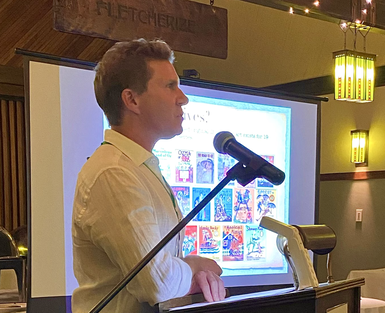 The Arts of Imagination Foundation also leant original copper printing plates, first used to publish the Oz books in the early 20th century, for use in a printmaking class utilizing the antique Roycroft printing press. Convention chair, Cindy Ragni did a fantastic job creating a weekend of fascinating conversation, education, and exploration between collectors and scholars who have provided invaluable insights and support to our endeavors. Recently, we chronicled the exciting rediscovery of an original full-page pen and ink illustration drawn by W.W. Denslow for THE WONDERFUL WIZARD OF OZ in 1900. This was the first major Oz find of its kind in decades, and it gave hope that even after over 120 years, works of this importance are still out there waiting to be discovered. Lightning struck again when two additional full-page illustrations by Denslow for THE WIZARD surprisingly turned up at Bradford’s Auction Gallery in Arizona. Bradford’s Auction Gallery is a modest operation, specializing in area estate sales, and it was revealed that the Oz drawings came from an estate in northern Arizona near Sedona. The owners of the illustrations were not art collectors, and apparently had little idea of their value. The auction, which was conducted exclusively through an online internet bidding platform, generated immediate and excited interest, resulting in two record breaking sales for Denslow’s work. The first edition of THE WONDERFUL WIZARD OF OZ featured 24 color plate illustrations. With the discovery of these three drawings, only a handful of full-page drawings for the book are still at large, though only about 1/3 of the book’s total illustrations are accounted for. The search continues! A fun fact: Early copies of THE WONDERFUL WIZARD OF OZ feature red ‘hills’ on the horizon behind the Scarecrow and Stork. This has become one of the keynotes for identifying first state editions.
When I first launched The Lost Art of Oz project in 2018, I had no idea of the extraordinary adventure that was waiting for me. It began as a literary treasure hunt, but much like the story of Oz itself, it blossomed into a tale of friendship, community, and joyful personal discovery.
I believe connecting and reconnecting people to classic stories can uplift the world and help people to live their best lives. I feel it so strongly that in July of this year, I founded The Arts of Imagination Foundation to expand upon the work of The Lost Art of Oz, bringing the enduring power of timeless stories to an even bigger audience. On the horizon are outreach programs, partnerships on major museum exhibits, scholarships that support the art of storytelling, and, of course, ongoing preservation and championing of artwork and historic materials related to universal stories. For those who would like to adventure with us in a deeper way, as a 501(c)(3) tax exempt organization, your gifts and donations are 100% tax deductible. As we look to 2022, we at The Arts of Imagination Foundation wish each of you a year filled with health and joy. Speaking personally, I hope it’s also a year in which your personal yellow brick path ignites your imagination and inspires you to share it. When you share your light with the world, good things are not only possible – they are probable. We hope you will follow our journey! With greatest appreciation, Brady Schwind and The Arts of Imagination Foundation Life and work in Chicago during the early days of the 20th century meant a day to day adventure through a wild and wooly metropolis. Surrounded by the din and dust of industrial factories, streets crowded by thousands of workers, and a spider web of electrical wires that tended to inspire a weekly barrage of building fires, The Reilly & Britton Company made a decision in 1912 to get out. Relocating in May of that year to a quiet spot on Michigan Boulevard, where Grant Park and Lake Michigan kissed, must have seemed a luxurious - and bold - move to rivals in the publishing industry. But Reilly & Britton, started only a decade before had, like the city of Chicago itself, grown to surprising success. A success due mostly to the outstanding sales of a single author - L. Frank Baum. Settling into a new office, which occupied the entire 19,000 square foot fifth floor at the Graphic Arts Building, was a chance for the company to both consolidate its efforts, and expand its reach into limitless potential in what seemed to be an idyllic environment. A pair of newspaper advertisements, recently rediscovered by author, Michael Patrick Hearn, however, speak to an event (or perhaps even a series of events) that occurred scarcely a year into their new residence that must have rattled that confidence. A sale list posted by the Emporium Department Store in The San Francisco Chronicle on Sunday, February 8, 1914 announces that 3,000 juvenile books published by Reilly & Britton will be offered at cut prices after being water damaged due to a fire in an adjoining building. An ad a year later in The Washington Post offers similarly “spotted” lots from stock “suffered a loss through the unexpected release of [Reilly & Britton’s] sprinkling system.” In The Lost Art of Oz search, one of the central mysteries is the missing artwork for early Baum titles like Dorothy and the Wizard in Oz, John Dough and the Cherub, and Sky Island. Indeed, some of illustrator, John R. Neill’s most sumptuous efforts were drawn pre-1914, but are unaccounted for. Along with book stock, could original series artwork have been badly damaged in the event mentioned in these clippings? Not knowing how the artwork was stored in the firm’s offices, it does seem possible. And no doubt, if badly damaged by water or smoke, artwork which was drawn on illustration board in pen and ink or painted in watercolor might simply have been discarded. On the other hand, artwork from other early Reilly & Britton titles, like The Marvelous Land of Oz, Ozma of Oz, and The Road to Oz is known to survive, and none of it appears to have suffered any related fire or water damage. For now the evidence remains inconclusive. But the ads do provide an interesting speculative footnote into Oz archival history. Special thanks to Michael Patrick Hearn and Atticus Gannaway for providing materials and expert opinion for this article. When it comes to 'lost art,' the hope is always the same. That somebody out there somewhere will come across something long forgotten in an attic that turns out to be missing gold. It can be a pipe dream wish, but sometimes - just sometimes - as if from the Land of Oz itself, a little magic makes that miracle happen. Last week, I was contacted by a gentleman in Texas, who reached out about a drawing he had recently rediscovered. It had been in his family as long as he could remember, but always tucked away in a closet, along with the bits of paper, keys, and balls of string that tend to live in the bottom of drawers and that are carted house to house unexamined for generations. He knew little about the drawing itself, other than he thought it was something his granddaughters might enjoy, as it seemed to have something to do with the story of THE WIZARD OF OZ. Closer examination revealed that not only was the illustration, indeed, Oz related, it was one of W.W. Denslow's original pen and ink drawings for the first edition of THE WONDERFUL WIZARD IN OZ from 1900! Originally drawn for Chapter 19, "Attacked by the Fighting Trees," the illustration depicting the Scarecrow clutched in a 'woodsy' catch was colored during the printing process, and appeared as a full color plate drawing opposite page 220. Drawings by Denslow from THE WONDERFUL WIZARD OF OZ have scarcely been discovered in private hands, which makes this unexpected discovery a particularly exciting find. When asked about the drawing's provenance, the gentleman has few details, other than the memory it had been something the family, which hailed from the West Virginia area, had held onto for decades under the folklore that it might be something 'important.' His mother had been married to a prominent photographer in the 1920s, and his father lived in New York City in the same era, but nothing to concretely tie the illustration to its legendary past. Denslow's original artwork for THE WONDERFUL WIZARD OF OZ was among the lots offered in Chicago storage unit sales in the 1910s, after the artist failed to pay rent. A large collection of original pen and ink drawings for the book were later gifted to the New York Public Library in April, 1926 by noted book collector, Harry Goldsmith. A smaller cache of drawings turned up for sale at a Southern California bookseller in the 1960s, and in the decades since, scattered individual drawings have turned up at major auction houses. But as of 2021, only about one third of Denslow's total works for the classic book are confirmed to survive. As for the future of this drawing rediscovered in Texas: now armed with the knowledge of its value and importance, the owner will, at last, gift it a proper framing (and a proper insurance policy). It will also remain in the family for future generations to discover and enjoy. Hopefully, the uncovering will also inspire others to keep looking for long hidden treasures. After all, as this gentleman told me, 'you never know what might turn up in a closet after 121 years!' |
AuthorBrady Schwind is a writer, director, and Oz Enthusiast on a mission to definitively catalogue the existing original artwork from the famed "Famous Forty" Oz books. Archives
November 2023
Categories |









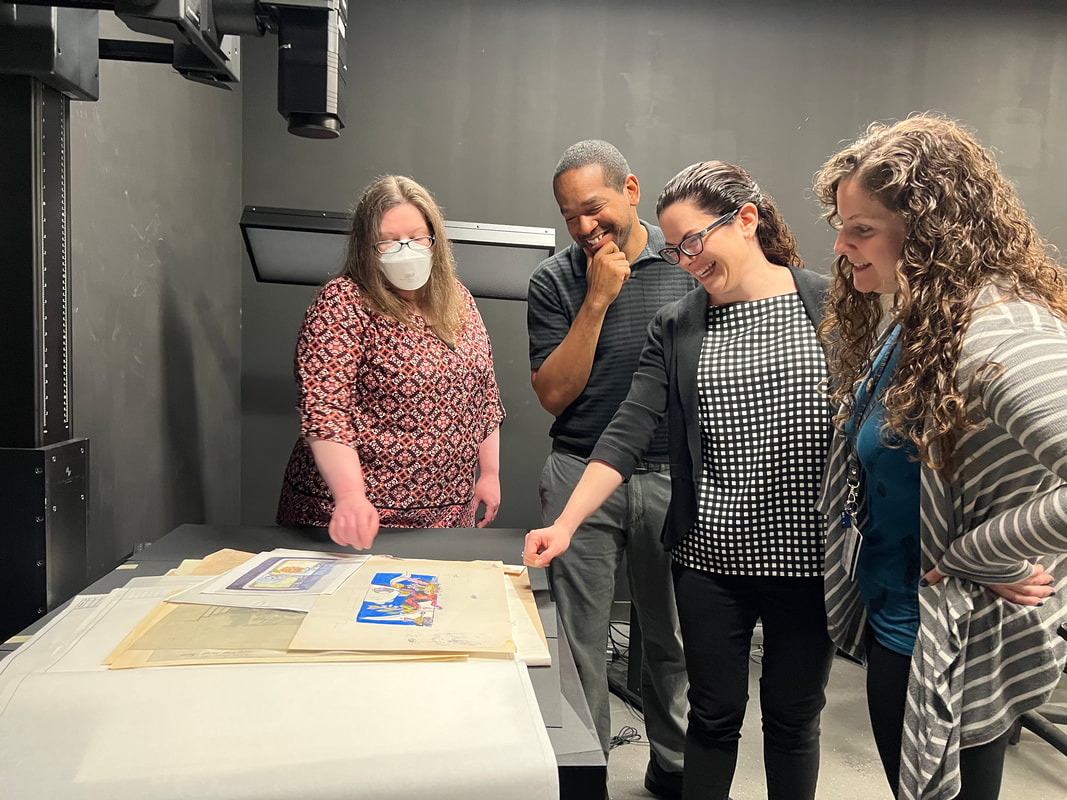
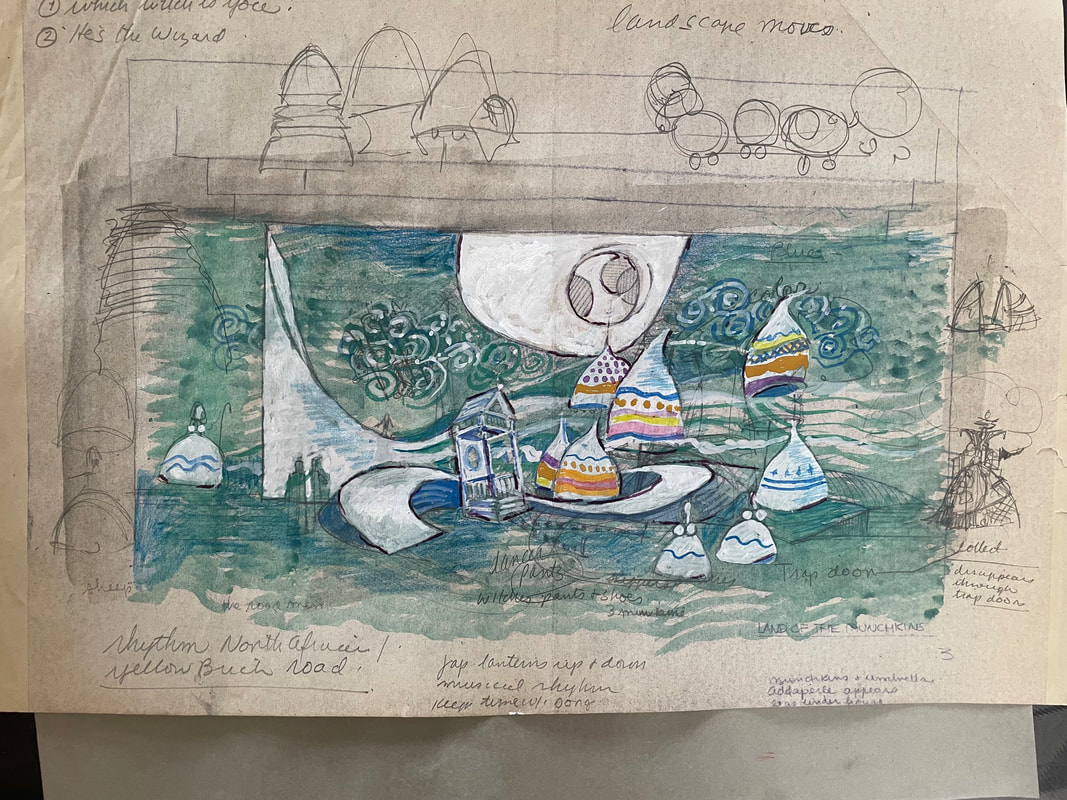
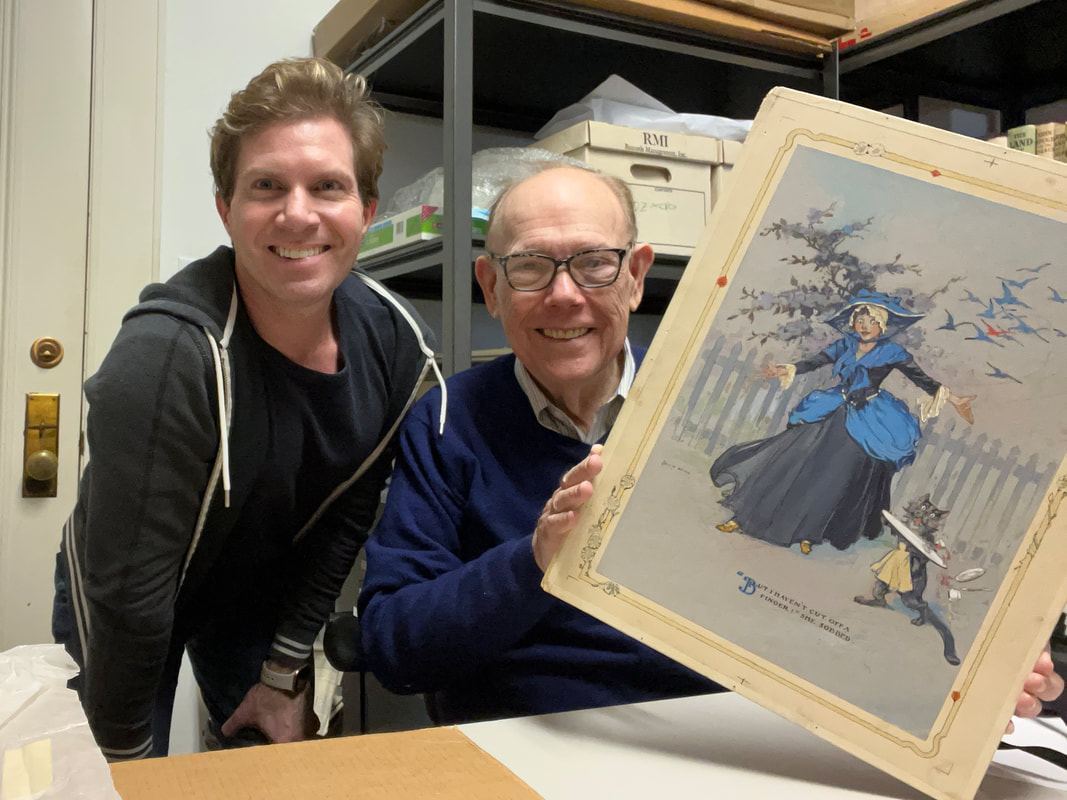













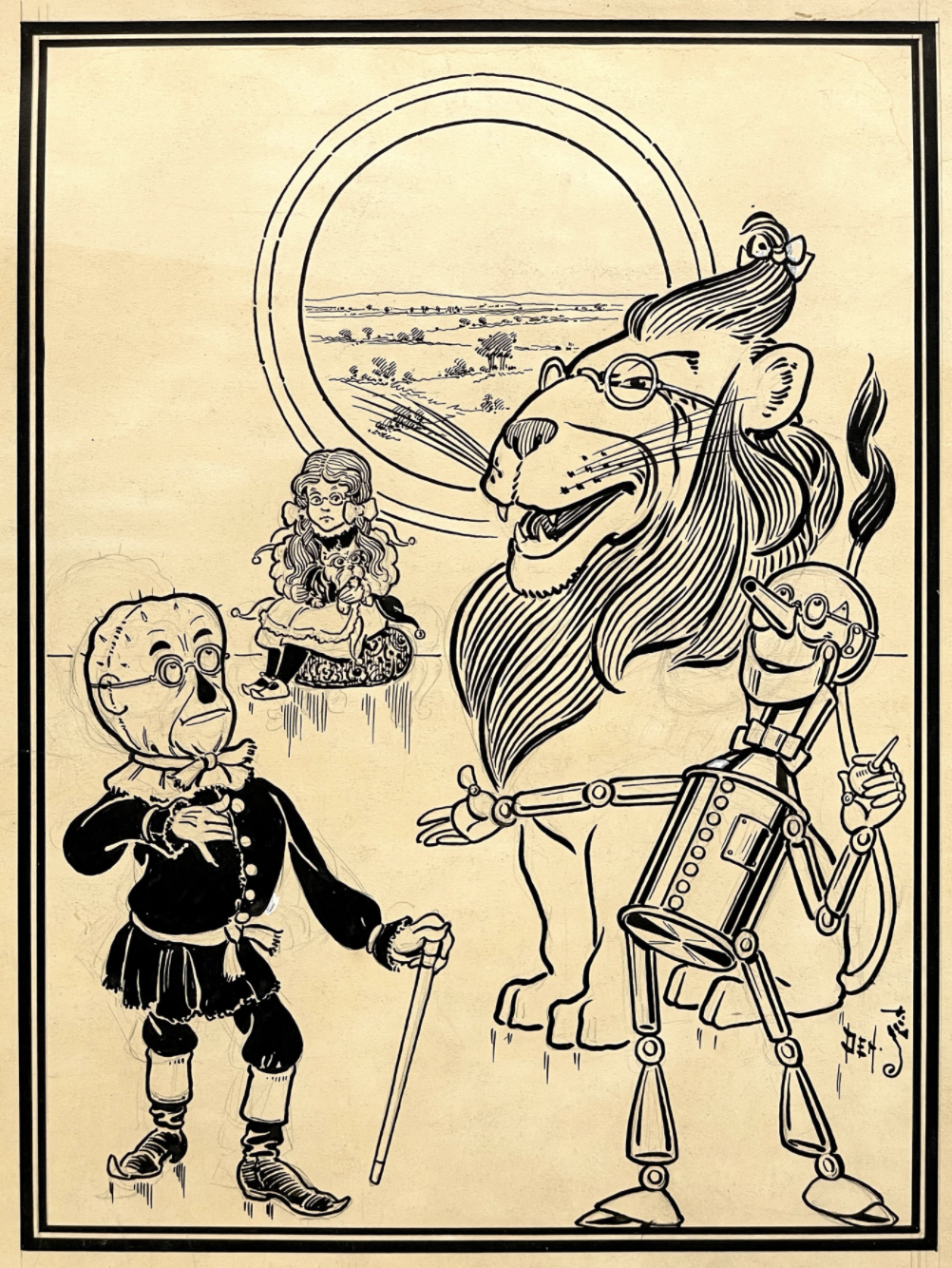
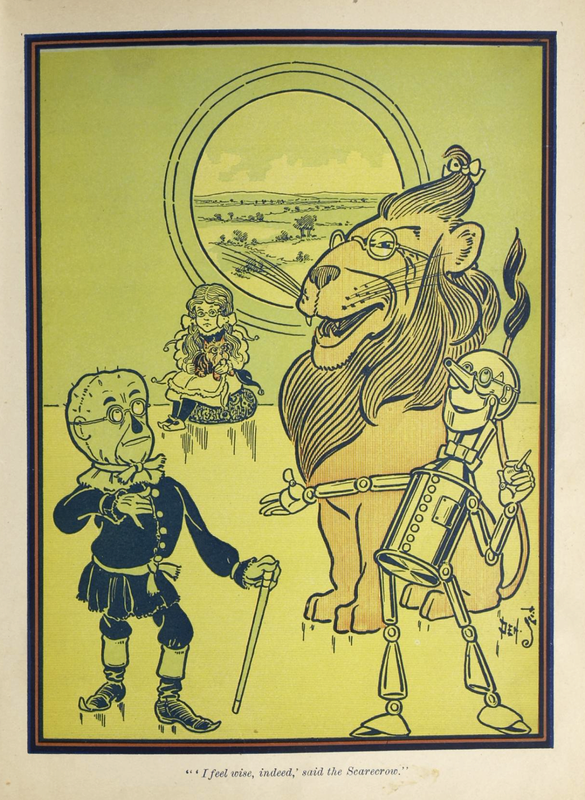

















 RSS Feed
RSS Feed
